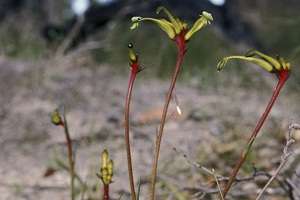Hotspot reveals new kangaroo paws

Two new species of kangaroo paw have been discovered in WA's biodiversity hotspot – the south-west of Australia – thanks to DNA sequencing.
UWA's Winthrop Professor of Biodiversity Stephen Hopper performed DNA sequencing on two kangaroo paws at the Royal Botanic Gardens in Kew, England, in collaboration with postdoctoral fellow Doctor Rhian Smith.
Prof Hopper says the new species were thought to be common bicolor kangaroo paws (Anigozanthos bicolor) but molecular sequencing revealed they differ genetically.
"The DNA has helped us unravel this evolutionary history of the kangaroo paws and very clearly shown there are two new species of kangaroo paw that have evolved at least twice independently," Prof Hopper says.
"They have been right under our noses but until we could look into DNA sequencing it was not clear that these two plants are quite different genetically to the bicoloured kangaroo paw.
"You can apply the technique of studying DNA sequence data to any living organism including plants … it is a very powerful, repeatable scientific approach to determining relationships."
DNA is taken from living leaf tissue sampled in the wild and a herbarium specimen to confirm identification and construct a 'tree' of species evolution.
"DNA is extracted in the Jodrell laboratory and the base pairs along selected parts of the molecule are sequenced by standard molecular techniques," he says.
"The gene regions selected are those that have become standard globally and found to vary among species across many groups of plants so that novel sequences can be compared with global records to confirm each sequence is producing accurate reproducible results.
"Standard statistical programs are then used to construct a phylogenetic tree from the sequence data, clearly illustrating relationships among species and so the statistical confidence can be placed on each branch in the 'evolutionary' tree for the organisms studied."
He says the discovery demonstrates WA's south-west is a biodiversity hotspot of global significance.
"The south-west from Shark Bay to Israelite Bay is the second richest biodiversity hotspot on the planet with a temperate climate."
"It is estimated something like 14 per cent of the plants in the south-west are still yet to be named scientifically.
"That percentage is equivalent to many rainforest areas so the south-west is right up there globally if you want to discover a new species and is an area gaining international attention."
The new species are yet to be named.
Provided by Science Network WA


















